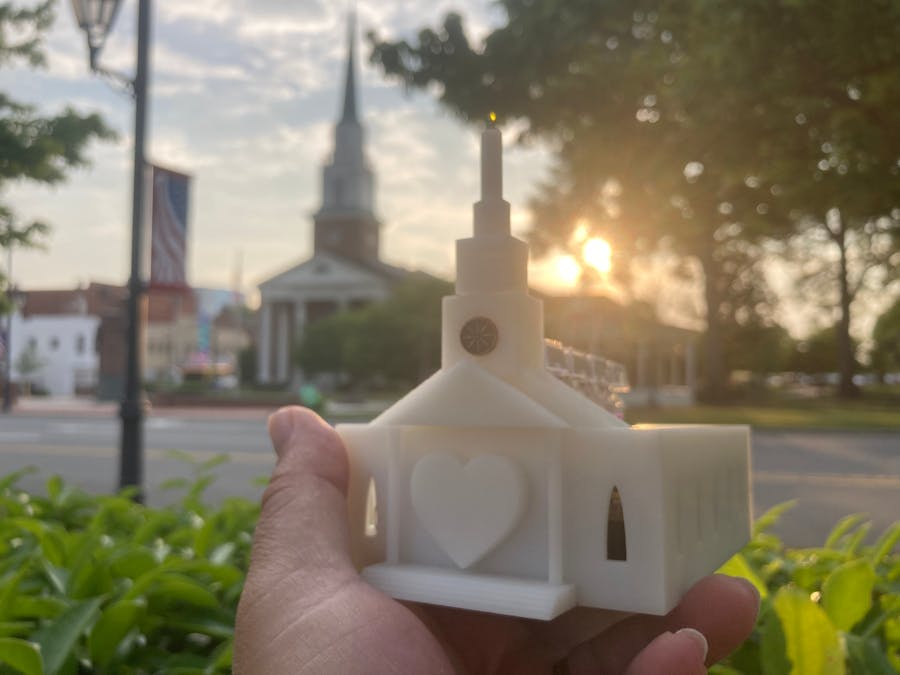Most churches have service ministries, like handy people to fix issues inside and outside a home. Fall season means leaf raking and stick pickup; so many leaves and sticks! And what about elders who are hungry? Churches have food ministries too. It also doesn't have to be church-based services; any service can be connected.
It's time to connect the dots using some awesome hardware and cool IoT technology!
Non-emergency Service ButtonsAdafruit makes inspiring hardware and this little NeoKey 1x4 button pad was the spark of my idea!
Whether you call it I2C or Qwiic or Stemma QT or QW/ST or SCSI (just kidding sort-of) 🌼 daisy 🌼 chains 🌼 are 🌼 great! And solderless too!
Make Your Own Photo KeycapsPrayer Visit Button
Food Visit Button
Handy Visit Button
Lawn Visit Button
Elders don't have Wi-fi networks.
My device requires a network and I can't assume elders have any form of wireless network. I could go big and build my own LoRa municipal network, but I don't really want to sink time into that, if I don't have to. How about going small instead?
Requirement Exceeded: Blues LTE NotecardWhen you buy a Blues LTE Notecard, you receive enough built-in, prepaid LTE connectivity and cloud integration credits to probably last for the entire lifetime of your device, especially a very low-volume communications device like mine.
The diminutive Blues Notecard plugs into your choice of carrier boards; I chose the Notecarrier-F and its companion Swan R5 Feather.
Blues Notecarrier-B above is pure simplicity with its QT connectedness; I'm eyeballing it for future smaller sized device implementations.
SparkFun Electronics also carries the Blues MicroMod Starter Kit which gives devs their choice of microprocessor too. It's a veritable buffet of electronics choices pictured below!
I would be remiss if I didn't spotlight Blues' open hardware repository, which electronics wizards can (and have) remixed into new, optimal devices to solve specific problems and use cases. I would love to learn how to craft my own PCBs... I think I can! I think I can! 🚂
I intended the device to be powered by MicroPython / CircuitPython as a professional challenge; this code can be reused to serve as the foundation for many "service button" ideas swimming around in my head. 🐬 🧠
Elder Device OperationElder presses any given service button and a JSON message is sent from the device over LTE to Blues Notehub.io then sent to Twilio's SMS API to send alerts to defined service teams.
Blues LTE Notecard has built-in cellular triangulation which is totally awesome, but my device required an higher level of precision to enable door-to-door mapping for service teams. I use the GPS coordinates to generate a very precise Google Maps SMSed to services teams. FYI: There is code to make the NeoKey's buttons turn red when there's not a GPS fix. I do recommend the device being placed closer to a window than not, but big things come in tiny packages... I've been pleasantly surprised at getting double-digit satellite connections while being fully inside a home or building.
This project is focused on non-emergency services, but with a high precision GPS on-board, it does become feasible to connect the device to an emergency help service like Noonlight's API. It also becomes possible to get transportation services for elder trips to the doctor or food deliveries using Uber's API.
My goal for the device is a take home device; just grab and take to an elder's home. But how does the device know anything about its user? My code.py ships with some generic names and defaults, but Blue's cloud provides developers a method to set environmental variables on a per-device basis over LTE. So that's the foundation of my device's registration. Here's How-to make Google Forms submit fields as JSON to an API endpoint of your choosing.
While I was sleeping, Blues was solving more problems that I hadn't even thought of yet. How would I know if a remote device is stuck and needs resetting? What if I have a software bug or optimization, how would I deploy an update remotely? Blues has pulled out all the stops for developers with its Fleet Management toolset and Notecard Outboard Firmware Updating.
In a nutshell, "outboard" means Blues' LTE Notecard can instantiate a connected microprocessor's firmware update.
My device's case is intentionally designed to be very familiar to the elders of a particular church. A 3D modeled enclosure can be made to resemble any place that's familiar to elders. Their home church, temple, mosque, tent, whatever you feel would make a connection with your elders. I've also used a sufficient amount of LEDs to make it appealing, inspire curiosity, and double as a night light. Button light intensity can be programmatically dimmed after dark, leaving only the steeple's birthday candle-like LED on. How to get the current time on a microprocessor? LTE time!
- Hourly chime/song with nighttime muting?
- BIG buttons for increased elder usability?
- Elimination of buttons in favor of contactless Jedi hand wave or hover using Time of Flight Distance Sensors?
- FM Radio for audio content?
- AWS Polly for transforming pastor daily devotion blog into into spoken audio?
- Include environmental sensors like air quality? I'm actually trying to increase human visits to elders with this device, not lower visits; this idea requires careful consideration.
- Take the buttons to the street in the form of heavy duty crosswalk-style buttons for summoning bookmobiles and meals for food insecure communities.
- I believe there's a lot of good community services but not a lot of connectivity between services and people in need.
- Please take anything of merit from this and do some good in your community! We simply wouldn't be here without our elders.
As Jesus looked up, he saw the rich putting their gifts into the temple treasury. He also saw a poor widow put in two very small copper coins. “Truly I tell you, ” he said, “this poor widow has put in more than all the others. All these people gave their gifts out of their wealth; but she out of her poverty put in all she had to live on.” -- Luke 21 (NIV)
I've embedded a replica coin into the steeple of my prototype's 3D printed enclosure, It's not child-safe though, so it probably will not make it to production deployments. I can certainly give the coins out when demoing the device in-person as a memento!
Collaborations WantedWould your elders, community, non-profit, or public school benefit from any of this technology or know-how? Please reach out: bradspry at gmail com. Constructive feedback is always welcome too.












_t9PF3orMPd.png?auto=compress%2Cformat&w=40&h=40&fit=fillmax&bg=fff&dpr=2)





Comments
Please log in or sign up to comment.